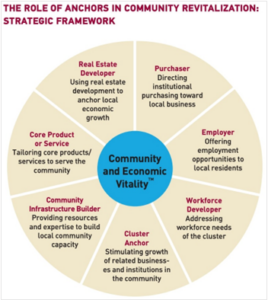Anchor institutions are those that are well established and deeply ingrained in their communities, both socially and economically; the institution and the community are interdependent. Initially, anchor institutions referred to colleges, universities, medical centers, and public utilities. Then arts and cultural institutions and sports venues were added to the list, as were religious institutions. Considering anchors’ role in community revitalization (framework pictured below) and given their footprint and influence in local economies and ecosystems, it makes sense to add corporations to the list as well. Corporate purpose and community investment elevate the responsibility and the contribution of corporate anchors to be not only in and of the community but also for the community.

FSG’s Advancing Strategy report, developed in partnership with CECP, offers guidance for companies to shape their local giving strategy to reflect local business needs and context. The report provides tools to develop context-specific signature initiatives and clustered local giving tailored to local needs, as well as partnership approaches and selection. These strategies are applicable to both headquarters (HQ) and operating region community giving. Below are a few examples of CECP-affiliated companies embracing their role as anchor institutions through HQ community giving.
Context-Specific Signature Initiative: The Hartford in Hartford, CT
To commemorate its centennial anniversary in 2020, the company committed $10 million over five years to the city’s Asylum Hill neighborhood. Through a survey, The Hartford sought input from individuals and nonprofit organizations in Asylum Hill to determine the neighborhood’s most pressing concerns. Noted by over half of all survey respondents were job readiness, housing stability, and safety. These concerns guided The Hartford’s selection of local partners and deployment of funds.
Clustered Local Giving: Northwestern Mutual in Milwaukee, WI
The company believes in and is committed to “a vibrant and diverse Milwaukee.” Northwestern Mutual’s efforts in Milwaukee have three focus areas: education (early childhood, K-12, and post-secondary), neighborhood investments (Amani, Metcalfe Park, and Muskego Way neighborhoods), and prominent destinations including the Milwaukee Zoo and Milwaukee Public Museum that provide cultural experiences and help the city flourish. The company has also sponsored a new community park designed for inclusive and accessible play.
Partnership Approaches and Selection: Prudential Financial in Newark, NJ
The Prudential Community Grants Program was launched in March 2023 to support neighborhood-based solutions and highlight community vitality by providing microgrants to residents and organizations in the five wards of Newark. The company has already distributed $280,000 to grantees and partners for 53 projects, averaging just over $5,000 per grant. Prudential activated partnerships to make the program successful, including intermediary organizations in each ward to provide application assistance and program marketing support, and the Community Foundation of New Jersey to administer and distribute the grants.
To be a company in, of, and for community, anchor your company in purpose through place-based community investment and partnerships. Want to learn more?
- Read CECP’s issue brief, Corporate Societal Engagement: Community Partnerships, for more ideas and resources.
- Request a peer connection with a company you admire to learn more about their place-based community investment strategy.
- Dive deeper to learn from other companies in your area through an expanded benchmarking Advanced Advisory project.


